Corporate Accounting Report: Financial Analysis of Bellamy's
VerifiedAdded on 2020/05/28
|15
|2910
|28
Report
AI Summary
This report delves into the corporate accounting practices of Bellamy's Australia Ltd, examining its financial challenges and the impact of continuous disclosure requirements. The report begins with an analysis of the company's financial issues, including trading halts, non-compliance with disclosure principles, and the suspension of milk-exporting licenses. It then investigates the company's financial statements, highlighting key aspects such as goodwill, asset acquisitions, cash positions, and profit and loss trends. The second part of the report focuses on the continuous disclosure regime for ASX-listed companies, emphasizing its importance for providing investors with adequate information, ensuring timely release of data, promoting equal access to information, preventing premature release, safeguarding commercial interests, and maintaining the confidentiality of information. The report concludes by asserting the necessity of a continuous disclosure framework for Australian companies, based on the benefits discussed in the literature review.
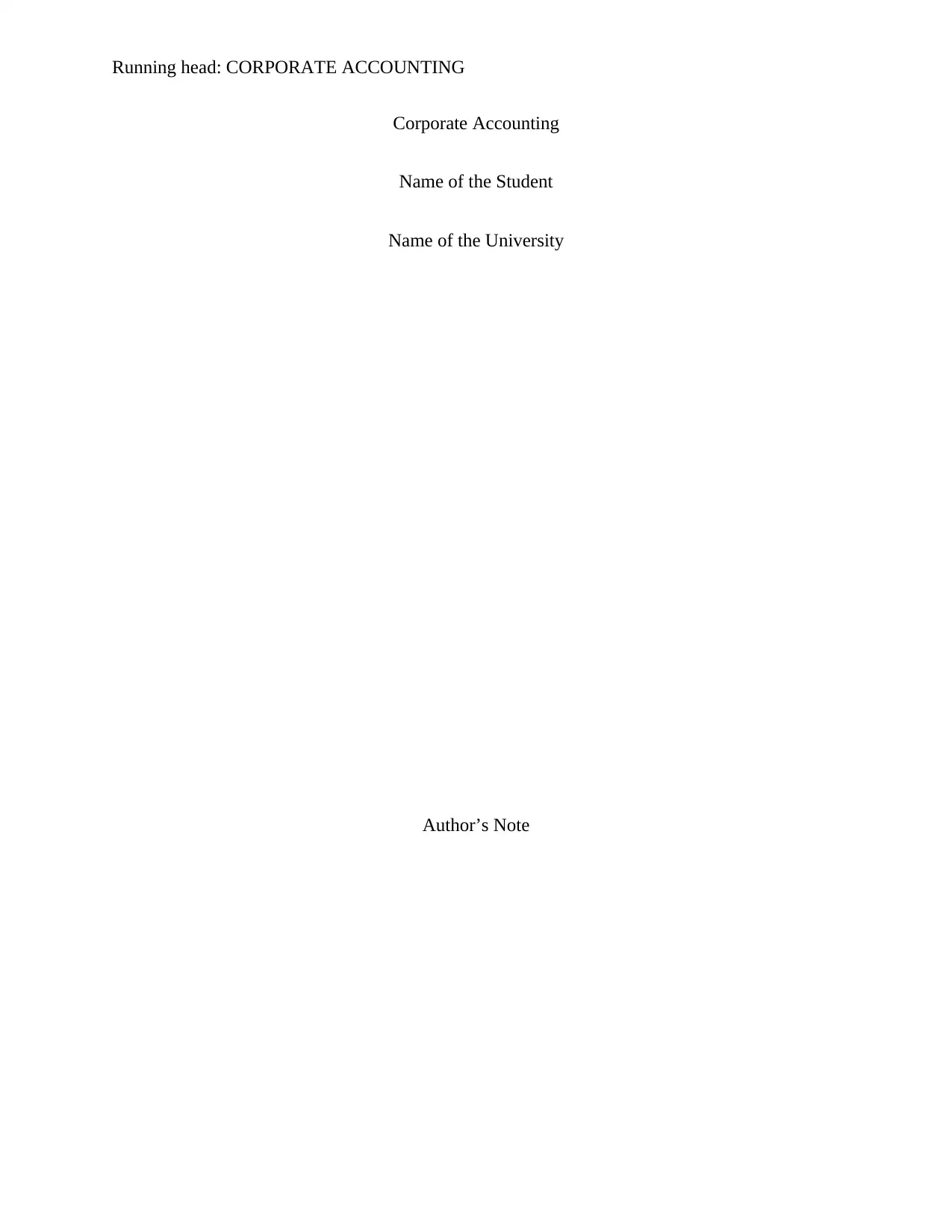
Running head: CORPORATE ACCOUNTING
Corporate Accounting
Name of the Student
Name of the University
Author’s Note
Corporate Accounting
Name of the Student
Name of the University
Author’s Note
Paraphrase This Document
Need a fresh take? Get an instant paraphrase of this document with our AI Paraphraser
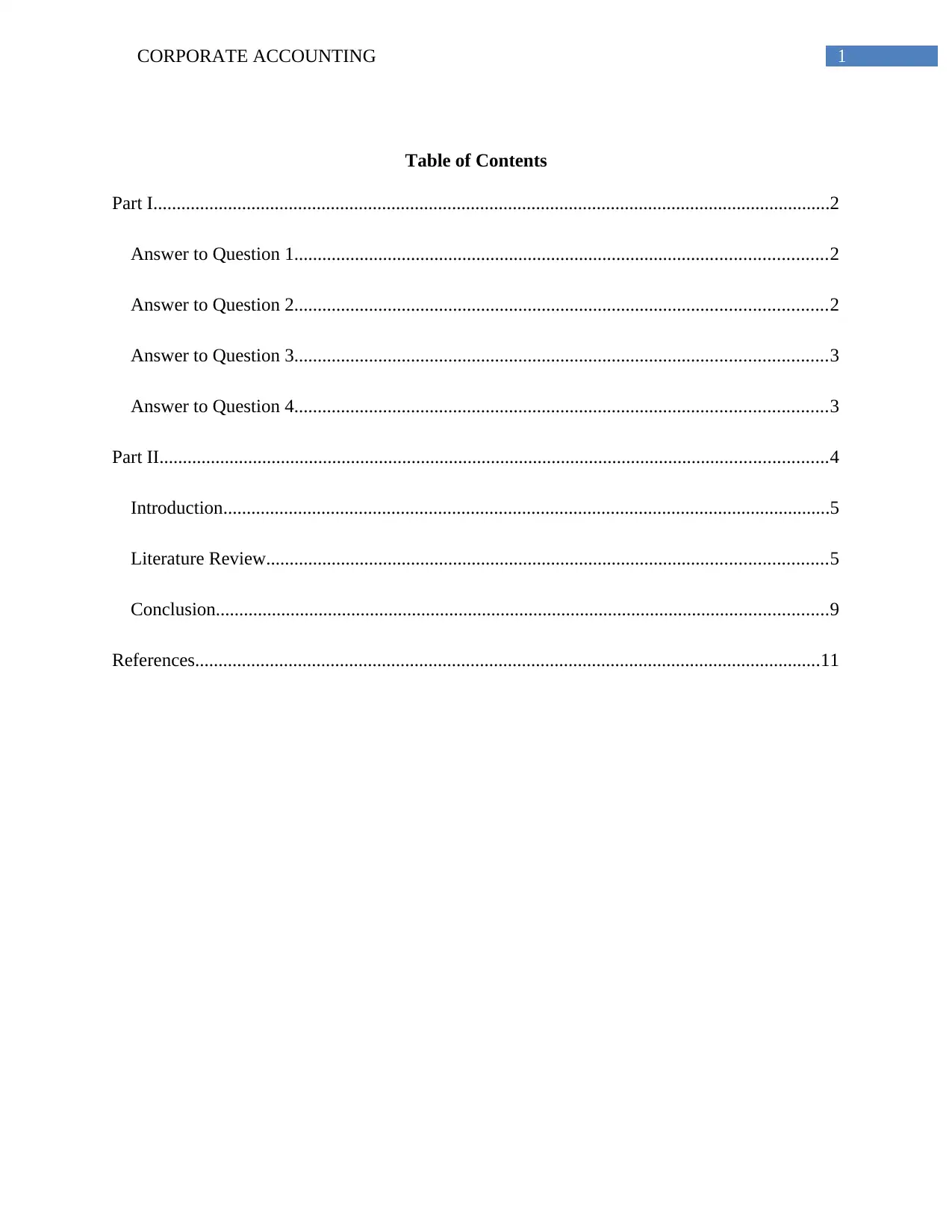
1CORPORATE ACCOUNTING
Table of Contents
Part I.................................................................................................................................................2
Answer to Question 1..................................................................................................................2
Answer to Question 2..................................................................................................................2
Answer to Question 3..................................................................................................................3
Answer to Question 4..................................................................................................................3
Part II...............................................................................................................................................4
Introduction..................................................................................................................................5
Literature Review........................................................................................................................5
Conclusion...................................................................................................................................9
References......................................................................................................................................11
Table of Contents
Part I.................................................................................................................................................2
Answer to Question 1..................................................................................................................2
Answer to Question 2..................................................................................................................2
Answer to Question 3..................................................................................................................3
Answer to Question 4..................................................................................................................3
Part II...............................................................................................................................................4
Introduction..................................................................................................................................5
Literature Review........................................................................................................................5
Conclusion...................................................................................................................................9
References......................................................................................................................................11
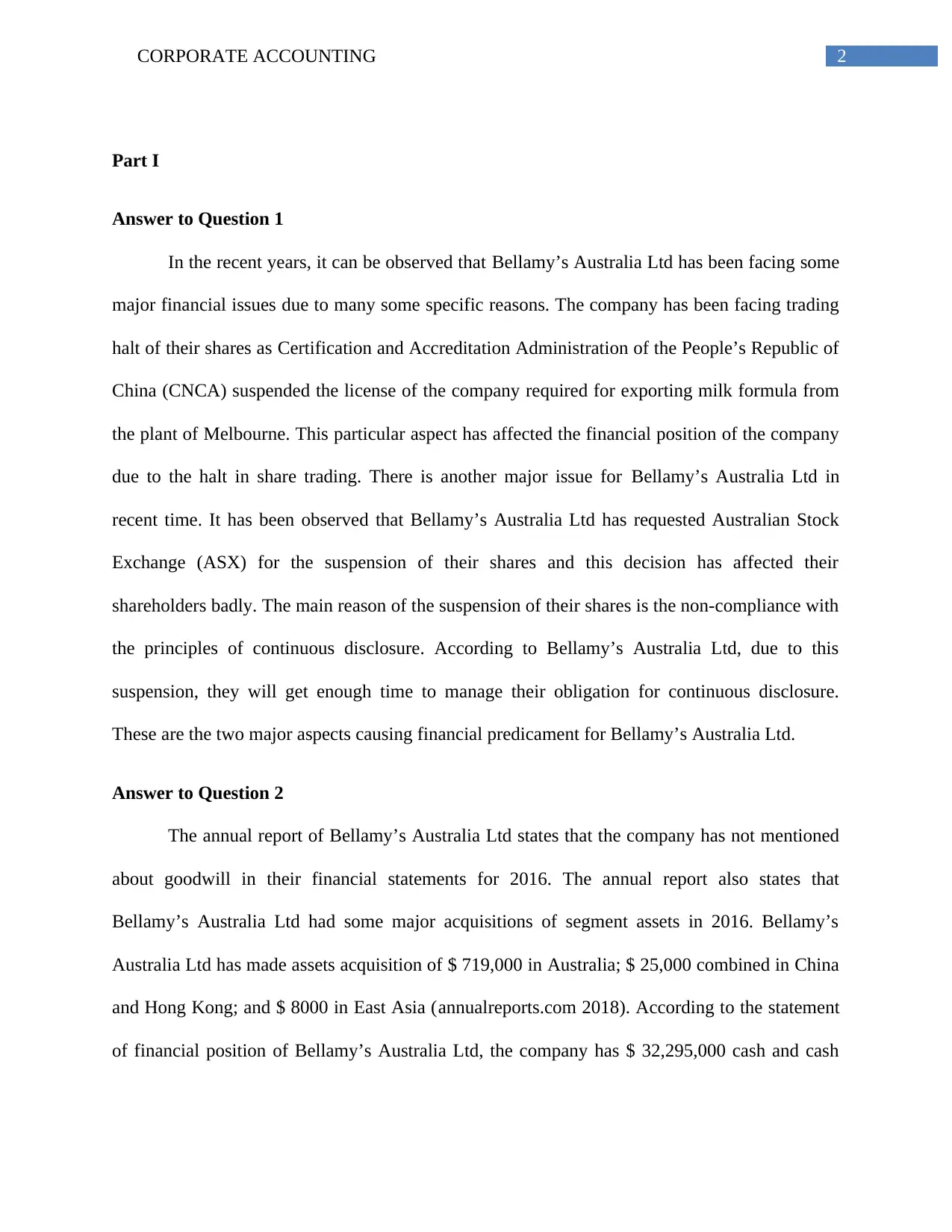
2CORPORATE ACCOUNTING
Part I
Answer to Question 1
In the recent years, it can be observed that Bellamy’s Australia Ltd has been facing some
major financial issues due to many some specific reasons. The company has been facing trading
halt of their shares as Certification and Accreditation Administration of the People’s Republic of
China (CNCA) suspended the license of the company required for exporting milk formula from
the plant of Melbourne. This particular aspect has affected the financial position of the company
due to the halt in share trading. There is another major issue for Bellamy’s Australia Ltd in
recent time. It has been observed that Bellamy’s Australia Ltd has requested Australian Stock
Exchange (ASX) for the suspension of their shares and this decision has affected their
shareholders badly. The main reason of the suspension of their shares is the non-compliance with
the principles of continuous disclosure. According to Bellamy’s Australia Ltd, due to this
suspension, they will get enough time to manage their obligation for continuous disclosure.
These are the two major aspects causing financial predicament for Bellamy’s Australia Ltd.
Answer to Question 2
The annual report of Bellamy’s Australia Ltd states that the company has not mentioned
about goodwill in their financial statements for 2016. The annual report also states that
Bellamy’s Australia Ltd had some major acquisitions of segment assets in 2016. Bellamy’s
Australia Ltd has made assets acquisition of $ 719,000 in Australia; $ 25,000 combined in China
and Hong Kong; and $ 8000 in East Asia (annualreports.com 2018). According to the statement
of financial position of Bellamy’s Australia Ltd, the company has $ 32,295,000 cash and cash
Part I
Answer to Question 1
In the recent years, it can be observed that Bellamy’s Australia Ltd has been facing some
major financial issues due to many some specific reasons. The company has been facing trading
halt of their shares as Certification and Accreditation Administration of the People’s Republic of
China (CNCA) suspended the license of the company required for exporting milk formula from
the plant of Melbourne. This particular aspect has affected the financial position of the company
due to the halt in share trading. There is another major issue for Bellamy’s Australia Ltd in
recent time. It has been observed that Bellamy’s Australia Ltd has requested Australian Stock
Exchange (ASX) for the suspension of their shares and this decision has affected their
shareholders badly. The main reason of the suspension of their shares is the non-compliance with
the principles of continuous disclosure. According to Bellamy’s Australia Ltd, due to this
suspension, they will get enough time to manage their obligation for continuous disclosure.
These are the two major aspects causing financial predicament for Bellamy’s Australia Ltd.
Answer to Question 2
The annual report of Bellamy’s Australia Ltd states that the company has not mentioned
about goodwill in their financial statements for 2016. The annual report also states that
Bellamy’s Australia Ltd had some major acquisitions of segment assets in 2016. Bellamy’s
Australia Ltd has made assets acquisition of $ 719,000 in Australia; $ 25,000 combined in China
and Hong Kong; and $ 8000 in East Asia (annualreports.com 2018). According to the statement
of financial position of Bellamy’s Australia Ltd, the company has $ 32,295,000 cash and cash
⊘ This is a preview!⊘
Do you want full access?
Subscribe today to unlock all pages.

Trusted by 1+ million students worldwide
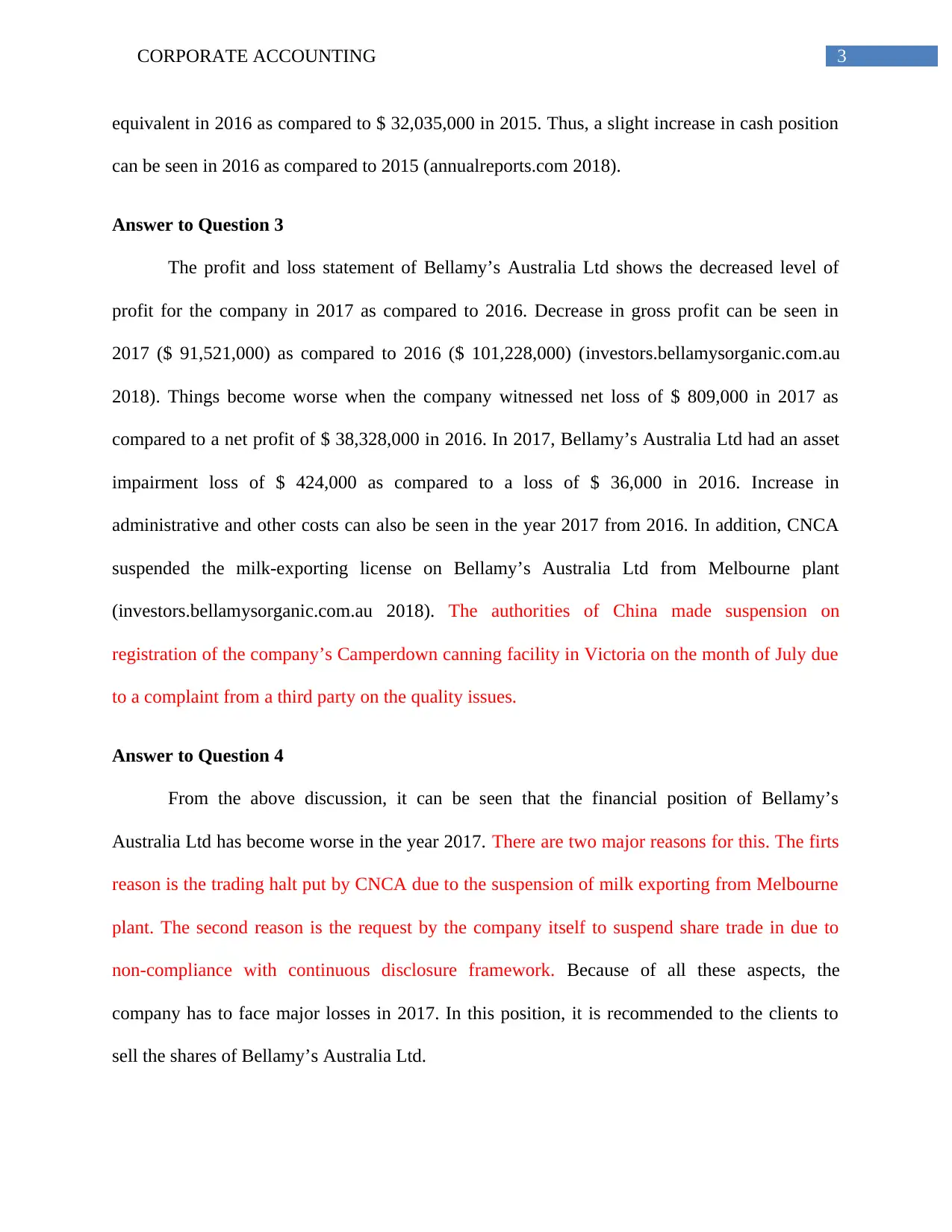
3CORPORATE ACCOUNTING
equivalent in 2016 as compared to $ 32,035,000 in 2015. Thus, a slight increase in cash position
can be seen in 2016 as compared to 2015 (annualreports.com 2018).
Answer to Question 3
The profit and loss statement of Bellamy’s Australia Ltd shows the decreased level of
profit for the company in 2017 as compared to 2016. Decrease in gross profit can be seen in
2017 ($ 91,521,000) as compared to 2016 ($ 101,228,000) (investors.bellamysorganic.com.au
2018). Things become worse when the company witnessed net loss of $ 809,000 in 2017 as
compared to a net profit of $ 38,328,000 in 2016. In 2017, Bellamy’s Australia Ltd had an asset
impairment loss of $ 424,000 as compared to a loss of $ 36,000 in 2016. Increase in
administrative and other costs can also be seen in the year 2017 from 2016. In addition, CNCA
suspended the milk-exporting license on Bellamy’s Australia Ltd from Melbourne plant
(investors.bellamysorganic.com.au 2018). The authorities of China made suspension on
registration of the company’s Camperdown canning facility in Victoria on the month of July due
to a complaint from a third party on the quality issues.
Answer to Question 4
From the above discussion, it can be seen that the financial position of Bellamy’s
Australia Ltd has become worse in the year 2017. There are two major reasons for this. The firts
reason is the trading halt put by CNCA due to the suspension of milk exporting from Melbourne
plant. The second reason is the request by the company itself to suspend share trade in due to
non-compliance with continuous disclosure framework. Because of all these aspects, the
company has to face major losses in 2017. In this position, it is recommended to the clients to
sell the shares of Bellamy’s Australia Ltd.
equivalent in 2016 as compared to $ 32,035,000 in 2015. Thus, a slight increase in cash position
can be seen in 2016 as compared to 2015 (annualreports.com 2018).
Answer to Question 3
The profit and loss statement of Bellamy’s Australia Ltd shows the decreased level of
profit for the company in 2017 as compared to 2016. Decrease in gross profit can be seen in
2017 ($ 91,521,000) as compared to 2016 ($ 101,228,000) (investors.bellamysorganic.com.au
2018). Things become worse when the company witnessed net loss of $ 809,000 in 2017 as
compared to a net profit of $ 38,328,000 in 2016. In 2017, Bellamy’s Australia Ltd had an asset
impairment loss of $ 424,000 as compared to a loss of $ 36,000 in 2016. Increase in
administrative and other costs can also be seen in the year 2017 from 2016. In addition, CNCA
suspended the milk-exporting license on Bellamy’s Australia Ltd from Melbourne plant
(investors.bellamysorganic.com.au 2018). The authorities of China made suspension on
registration of the company’s Camperdown canning facility in Victoria on the month of July due
to a complaint from a third party on the quality issues.
Answer to Question 4
From the above discussion, it can be seen that the financial position of Bellamy’s
Australia Ltd has become worse in the year 2017. There are two major reasons for this. The firts
reason is the trading halt put by CNCA due to the suspension of milk exporting from Melbourne
plant. The second reason is the request by the company itself to suspend share trade in due to
non-compliance with continuous disclosure framework. Because of all these aspects, the
company has to face major losses in 2017. In this position, it is recommended to the clients to
sell the shares of Bellamy’s Australia Ltd.
Paraphrase This Document
Need a fresh take? Get an instant paraphrase of this document with our AI Paraphraser

4CORPORATE ACCOUNTING
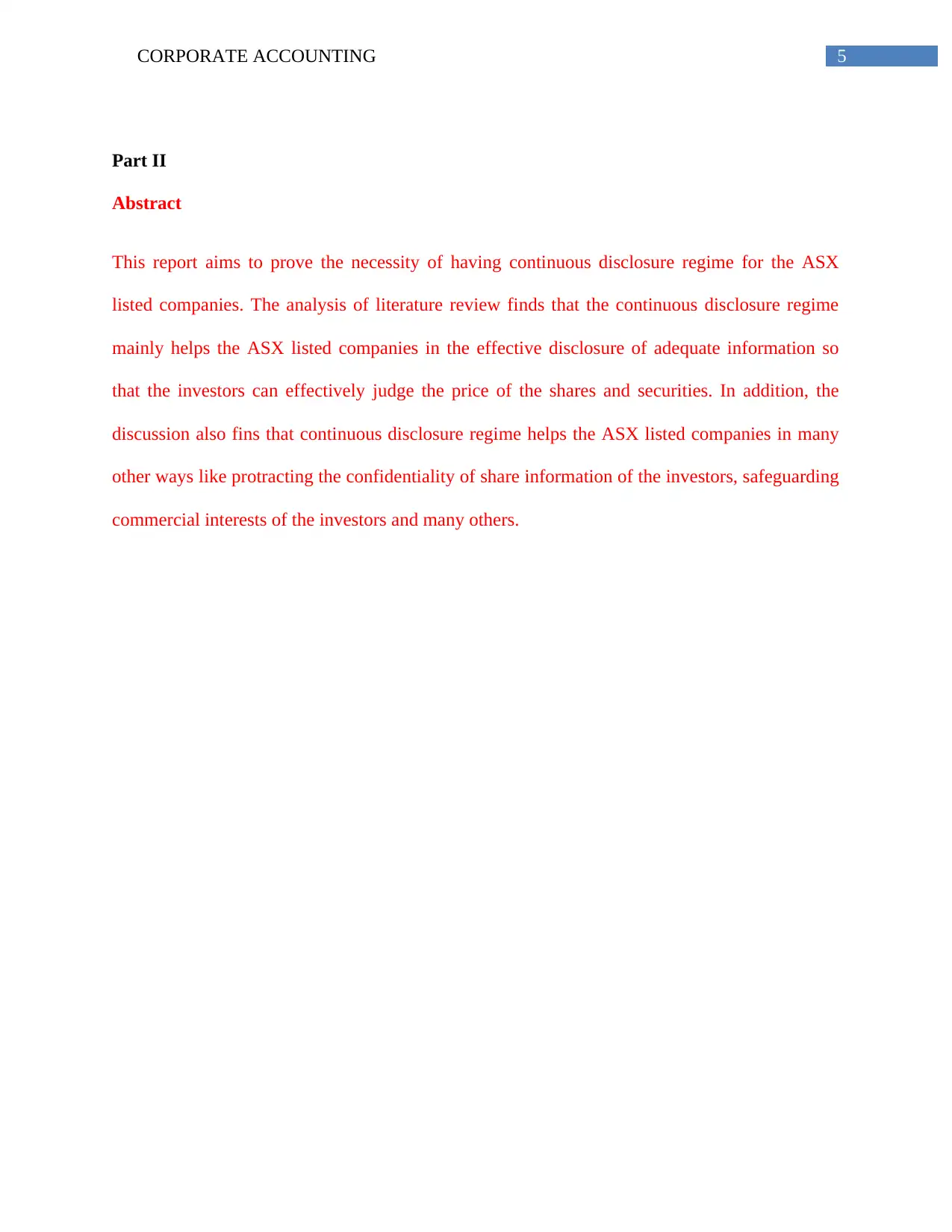
5CORPORATE ACCOUNTING
Part II
Abstract
This report aims to prove the necessity of having continuous disclosure regime for the ASX
listed companies. The analysis of literature review finds that the continuous disclosure regime
mainly helps the ASX listed companies in the effective disclosure of adequate information so
that the investors can effectively judge the price of the shares and securities. In addition, the
discussion also fins that continuous disclosure regime helps the ASX listed companies in many
other ways like protracting the confidentiality of share information of the investors, safeguarding
commercial interests of the investors and many others.
Part II
Abstract
This report aims to prove the necessity of having continuous disclosure regime for the ASX
listed companies. The analysis of literature review finds that the continuous disclosure regime
mainly helps the ASX listed companies in the effective disclosure of adequate information so
that the investors can effectively judge the price of the shares and securities. In addition, the
discussion also fins that continuous disclosure regime helps the ASX listed companies in many
other ways like protracting the confidentiality of share information of the investors, safeguarding
commercial interests of the investors and many others.
⊘ This is a preview!⊘
Do you want full access?
Subscribe today to unlock all pages.

Trusted by 1+ million students worldwide
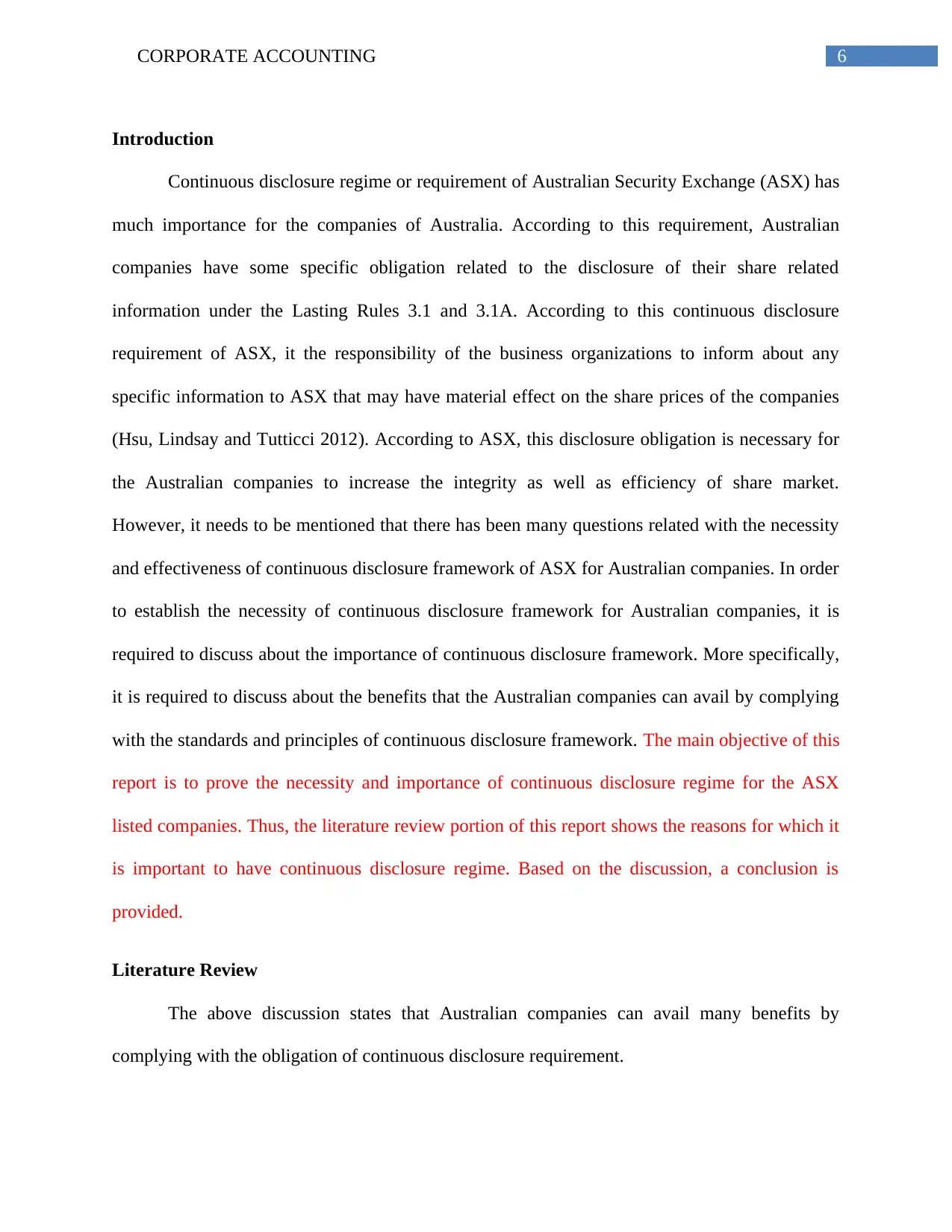
6CORPORATE ACCOUNTING
Introduction
Continuous disclosure regime or requirement of Australian Security Exchange (ASX) has
much importance for the companies of Australia. According to this requirement, Australian
companies have some specific obligation related to the disclosure of their share related
information under the Lasting Rules 3.1 and 3.1A. According to this continuous disclosure
requirement of ASX, it the responsibility of the business organizations to inform about any
specific information to ASX that may have material effect on the share prices of the companies
(Hsu, Lindsay and Tutticci 2012). According to ASX, this disclosure obligation is necessary for
the Australian companies to increase the integrity as well as efficiency of share market.
However, it needs to be mentioned that there has been many questions related with the necessity
and effectiveness of continuous disclosure framework of ASX for Australian companies. In order
to establish the necessity of continuous disclosure framework for Australian companies, it is
required to discuss about the importance of continuous disclosure framework. More specifically,
it is required to discuss about the benefits that the Australian companies can avail by complying
with the standards and principles of continuous disclosure framework. The main objective of this
report is to prove the necessity and importance of continuous disclosure regime for the ASX
listed companies. Thus, the literature review portion of this report shows the reasons for which it
is important to have continuous disclosure regime. Based on the discussion, a conclusion is
provided.
Literature Review
The above discussion states that Australian companies can avail many benefits by
complying with the obligation of continuous disclosure requirement.
Introduction
Continuous disclosure regime or requirement of Australian Security Exchange (ASX) has
much importance for the companies of Australia. According to this requirement, Australian
companies have some specific obligation related to the disclosure of their share related
information under the Lasting Rules 3.1 and 3.1A. According to this continuous disclosure
requirement of ASX, it the responsibility of the business organizations to inform about any
specific information to ASX that may have material effect on the share prices of the companies
(Hsu, Lindsay and Tutticci 2012). According to ASX, this disclosure obligation is necessary for
the Australian companies to increase the integrity as well as efficiency of share market.
However, it needs to be mentioned that there has been many questions related with the necessity
and effectiveness of continuous disclosure framework of ASX for Australian companies. In order
to establish the necessity of continuous disclosure framework for Australian companies, it is
required to discuss about the importance of continuous disclosure framework. More specifically,
it is required to discuss about the benefits that the Australian companies can avail by complying
with the standards and principles of continuous disclosure framework. The main objective of this
report is to prove the necessity and importance of continuous disclosure regime for the ASX
listed companies. Thus, the literature review portion of this report shows the reasons for which it
is important to have continuous disclosure regime. Based on the discussion, a conclusion is
provided.
Literature Review
The above discussion states that Australian companies can avail many benefits by
complying with the obligation of continuous disclosure requirement.
Paraphrase This Document
Need a fresh take? Get an instant paraphrase of this document with our AI Paraphraser
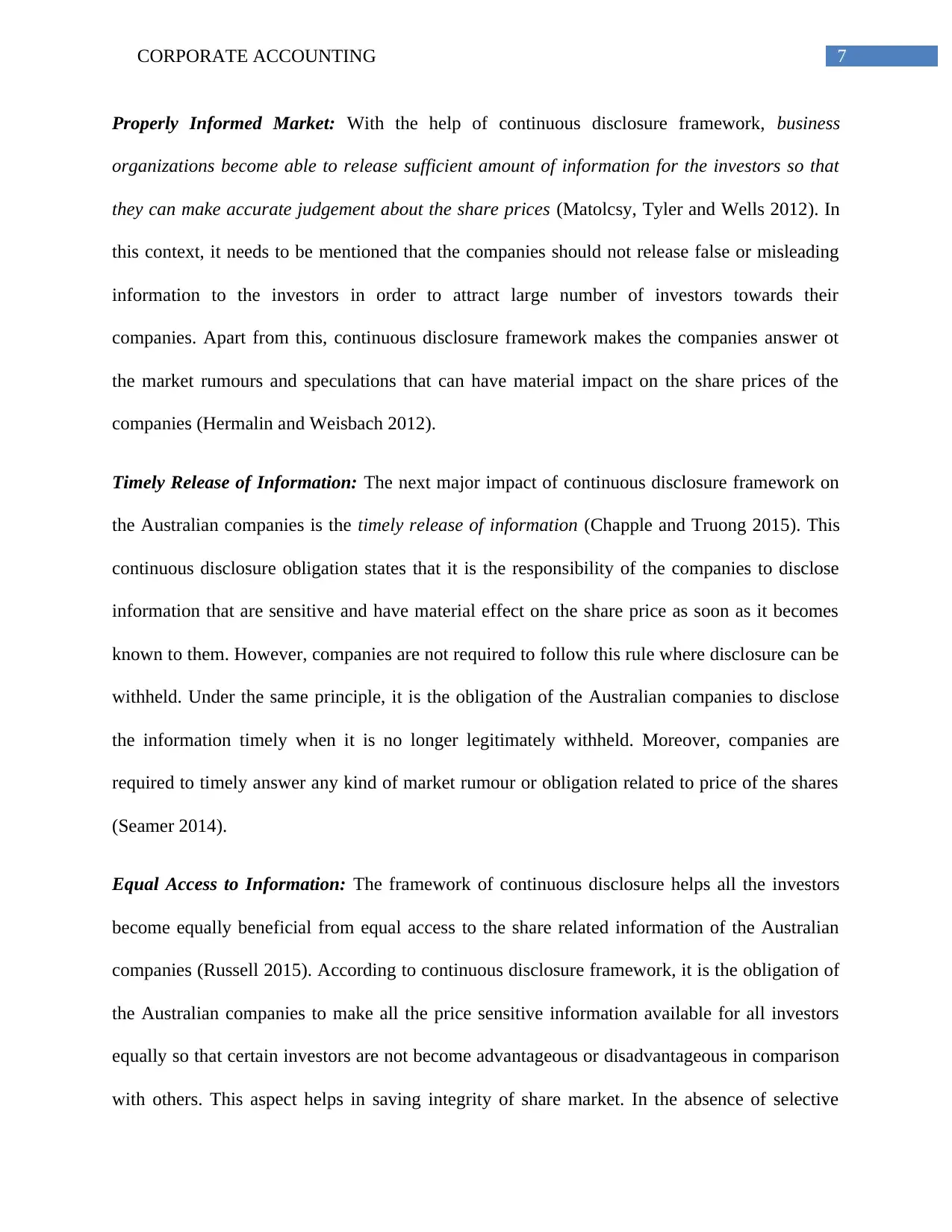
7CORPORATE ACCOUNTING
Properly Informed Market: With the help of continuous disclosure framework, business
organizations become able to release sufficient amount of information for the investors so that
they can make accurate judgement about the share prices (Matolcsy, Tyler and Wells 2012). In
this context, it needs to be mentioned that the companies should not release false or misleading
information to the investors in order to attract large number of investors towards their
companies. Apart from this, continuous disclosure framework makes the companies answer ot
the market rumours and speculations that can have material impact on the share prices of the
companies (Hermalin and Weisbach 2012).
Timely Release of Information: The next major impact of continuous disclosure framework on
the Australian companies is the timely release of information (Chapple and Truong 2015). This
continuous disclosure obligation states that it is the responsibility of the companies to disclose
information that are sensitive and have material effect on the share price as soon as it becomes
known to them. However, companies are not required to follow this rule where disclosure can be
withheld. Under the same principle, it is the obligation of the Australian companies to disclose
the information timely when it is no longer legitimately withheld. Moreover, companies are
required to timely answer any kind of market rumour or obligation related to price of the shares
(Seamer 2014).
Equal Access to Information: The framework of continuous disclosure helps all the investors
become equally beneficial from equal access to the share related information of the Australian
companies (Russell 2015). According to continuous disclosure framework, it is the obligation of
the Australian companies to make all the price sensitive information available for all investors
equally so that certain investors are not become advantageous or disadvantageous in comparison
with others. This aspect helps in saving integrity of share market. In the absence of selective
Properly Informed Market: With the help of continuous disclosure framework, business
organizations become able to release sufficient amount of information for the investors so that
they can make accurate judgement about the share prices (Matolcsy, Tyler and Wells 2012). In
this context, it needs to be mentioned that the companies should not release false or misleading
information to the investors in order to attract large number of investors towards their
companies. Apart from this, continuous disclosure framework makes the companies answer ot
the market rumours and speculations that can have material impact on the share prices of the
companies (Hermalin and Weisbach 2012).
Timely Release of Information: The next major impact of continuous disclosure framework on
the Australian companies is the timely release of information (Chapple and Truong 2015). This
continuous disclosure obligation states that it is the responsibility of the companies to disclose
information that are sensitive and have material effect on the share price as soon as it becomes
known to them. However, companies are not required to follow this rule where disclosure can be
withheld. Under the same principle, it is the obligation of the Australian companies to disclose
the information timely when it is no longer legitimately withheld. Moreover, companies are
required to timely answer any kind of market rumour or obligation related to price of the shares
(Seamer 2014).
Equal Access to Information: The framework of continuous disclosure helps all the investors
become equally beneficial from equal access to the share related information of the Australian
companies (Russell 2015). According to continuous disclosure framework, it is the obligation of
the Australian companies to make all the price sensitive information available for all investors
equally so that certain investors are not become advantageous or disadvantageous in comparison
with others. This aspect helps in saving integrity of share market. In the absence of selective
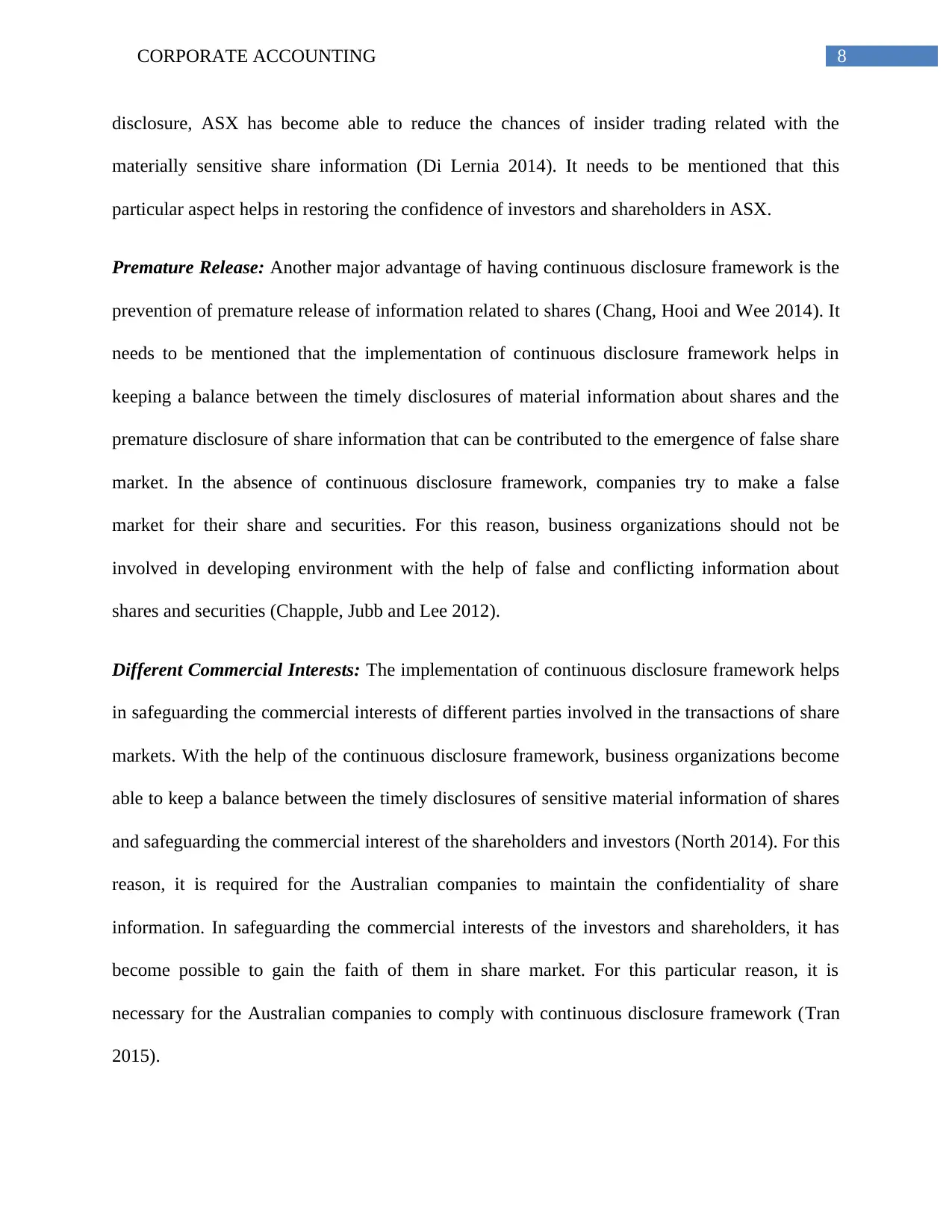
8CORPORATE ACCOUNTING
disclosure, ASX has become able to reduce the chances of insider trading related with the
materially sensitive share information (Di Lernia 2014). It needs to be mentioned that this
particular aspect helps in restoring the confidence of investors and shareholders in ASX.
Premature Release: Another major advantage of having continuous disclosure framework is the
prevention of premature release of information related to shares (Chang, Hooi and Wee 2014). It
needs to be mentioned that the implementation of continuous disclosure framework helps in
keeping a balance between the timely disclosures of material information about shares and the
premature disclosure of share information that can be contributed to the emergence of false share
market. In the absence of continuous disclosure framework, companies try to make a false
market for their share and securities. For this reason, business organizations should not be
involved in developing environment with the help of false and conflicting information about
shares and securities (Chapple, Jubb and Lee 2012).
Different Commercial Interests: The implementation of continuous disclosure framework helps
in safeguarding the commercial interests of different parties involved in the transactions of share
markets. With the help of the continuous disclosure framework, business organizations become
able to keep a balance between the timely disclosures of sensitive material information of shares
and safeguarding the commercial interest of the shareholders and investors (North 2014). For this
reason, it is required for the Australian companies to maintain the confidentiality of share
information. In safeguarding the commercial interests of the investors and shareholders, it has
become possible to gain the faith of them in share market. For this particular reason, it is
necessary for the Australian companies to comply with continuous disclosure framework (Tran
2015).
disclosure, ASX has become able to reduce the chances of insider trading related with the
materially sensitive share information (Di Lernia 2014). It needs to be mentioned that this
particular aspect helps in restoring the confidence of investors and shareholders in ASX.
Premature Release: Another major advantage of having continuous disclosure framework is the
prevention of premature release of information related to shares (Chang, Hooi and Wee 2014). It
needs to be mentioned that the implementation of continuous disclosure framework helps in
keeping a balance between the timely disclosures of material information about shares and the
premature disclosure of share information that can be contributed to the emergence of false share
market. In the absence of continuous disclosure framework, companies try to make a false
market for their share and securities. For this reason, business organizations should not be
involved in developing environment with the help of false and conflicting information about
shares and securities (Chapple, Jubb and Lee 2012).
Different Commercial Interests: The implementation of continuous disclosure framework helps
in safeguarding the commercial interests of different parties involved in the transactions of share
markets. With the help of the continuous disclosure framework, business organizations become
able to keep a balance between the timely disclosures of sensitive material information of shares
and safeguarding the commercial interest of the shareholders and investors (North 2014). For this
reason, it is required for the Australian companies to maintain the confidentiality of share
information. In safeguarding the commercial interests of the investors and shareholders, it has
become possible to gain the faith of them in share market. For this particular reason, it is
necessary for the Australian companies to comply with continuous disclosure framework (Tran
2015).
⊘ This is a preview!⊘
Do you want full access?
Subscribe today to unlock all pages.

Trusted by 1+ million students worldwide
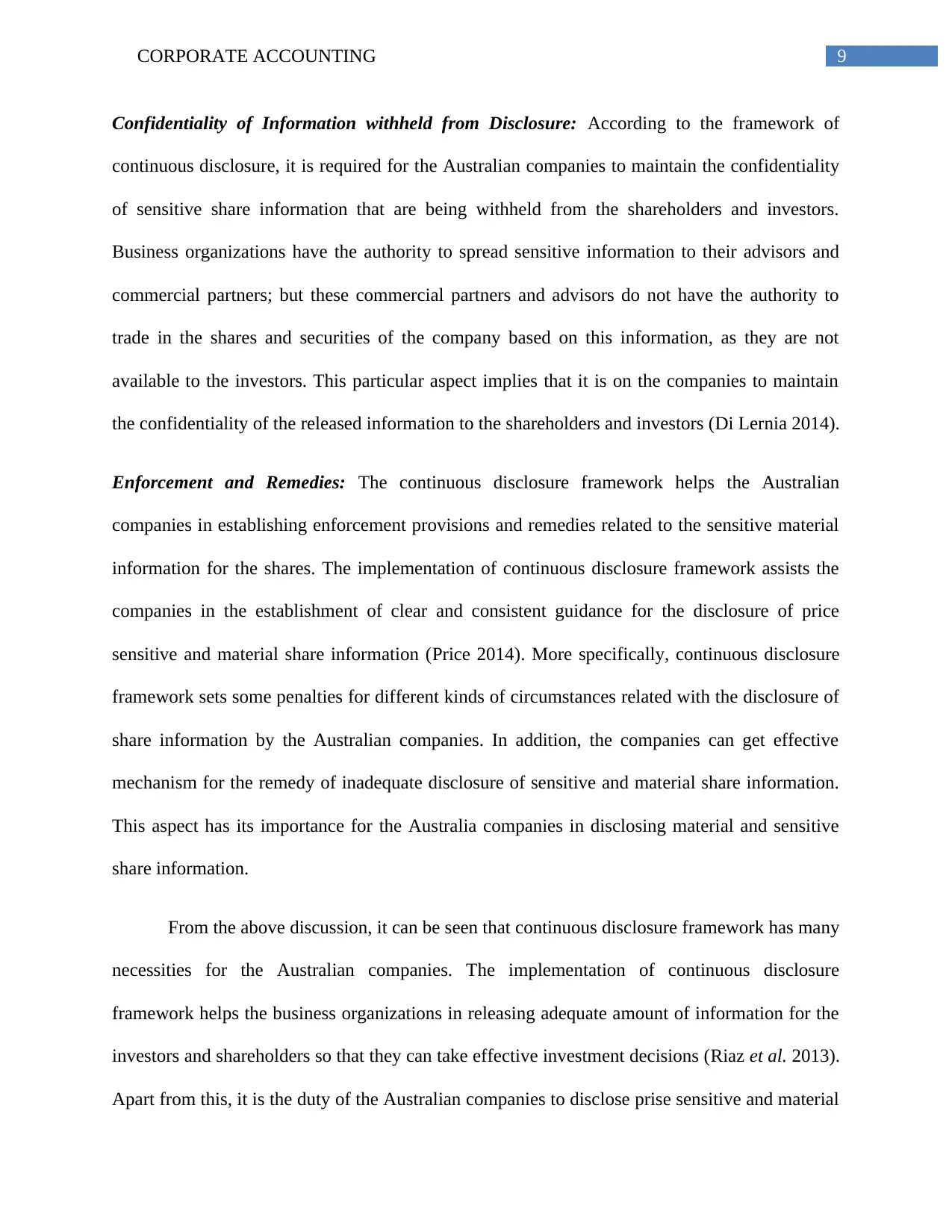
9CORPORATE ACCOUNTING
Confidentiality of Information withheld from Disclosure: According to the framework of
continuous disclosure, it is required for the Australian companies to maintain the confidentiality
of sensitive share information that are being withheld from the shareholders and investors.
Business organizations have the authority to spread sensitive information to their advisors and
commercial partners; but these commercial partners and advisors do not have the authority to
trade in the shares and securities of the company based on this information, as they are not
available to the investors. This particular aspect implies that it is on the companies to maintain
the confidentiality of the released information to the shareholders and investors (Di Lernia 2014).
Enforcement and Remedies: The continuous disclosure framework helps the Australian
companies in establishing enforcement provisions and remedies related to the sensitive material
information for the shares. The implementation of continuous disclosure framework assists the
companies in the establishment of clear and consistent guidance for the disclosure of price
sensitive and material share information (Price 2014). More specifically, continuous disclosure
framework sets some penalties for different kinds of circumstances related with the disclosure of
share information by the Australian companies. In addition, the companies can get effective
mechanism for the remedy of inadequate disclosure of sensitive and material share information.
This aspect has its importance for the Australia companies in disclosing material and sensitive
share information.
From the above discussion, it can be seen that continuous disclosure framework has many
necessities for the Australian companies. The implementation of continuous disclosure
framework helps the business organizations in releasing adequate amount of information for the
investors and shareholders so that they can take effective investment decisions (Riaz et al. 2013).
Apart from this, it is the duty of the Australian companies to disclose prise sensitive and material
Confidentiality of Information withheld from Disclosure: According to the framework of
continuous disclosure, it is required for the Australian companies to maintain the confidentiality
of sensitive share information that are being withheld from the shareholders and investors.
Business organizations have the authority to spread sensitive information to their advisors and
commercial partners; but these commercial partners and advisors do not have the authority to
trade in the shares and securities of the company based on this information, as they are not
available to the investors. This particular aspect implies that it is on the companies to maintain
the confidentiality of the released information to the shareholders and investors (Di Lernia 2014).
Enforcement and Remedies: The continuous disclosure framework helps the Australian
companies in establishing enforcement provisions and remedies related to the sensitive material
information for the shares. The implementation of continuous disclosure framework assists the
companies in the establishment of clear and consistent guidance for the disclosure of price
sensitive and material share information (Price 2014). More specifically, continuous disclosure
framework sets some penalties for different kinds of circumstances related with the disclosure of
share information by the Australian companies. In addition, the companies can get effective
mechanism for the remedy of inadequate disclosure of sensitive and material share information.
This aspect has its importance for the Australia companies in disclosing material and sensitive
share information.
From the above discussion, it can be seen that continuous disclosure framework has many
necessities for the Australian companies. The implementation of continuous disclosure
framework helps the business organizations in releasing adequate amount of information for the
investors and shareholders so that they can take effective investment decisions (Riaz et al. 2013).
Apart from this, it is the duty of the Australian companies to disclose prise sensitive and material
Paraphrase This Document
Need a fresh take? Get an instant paraphrase of this document with our AI Paraphraser
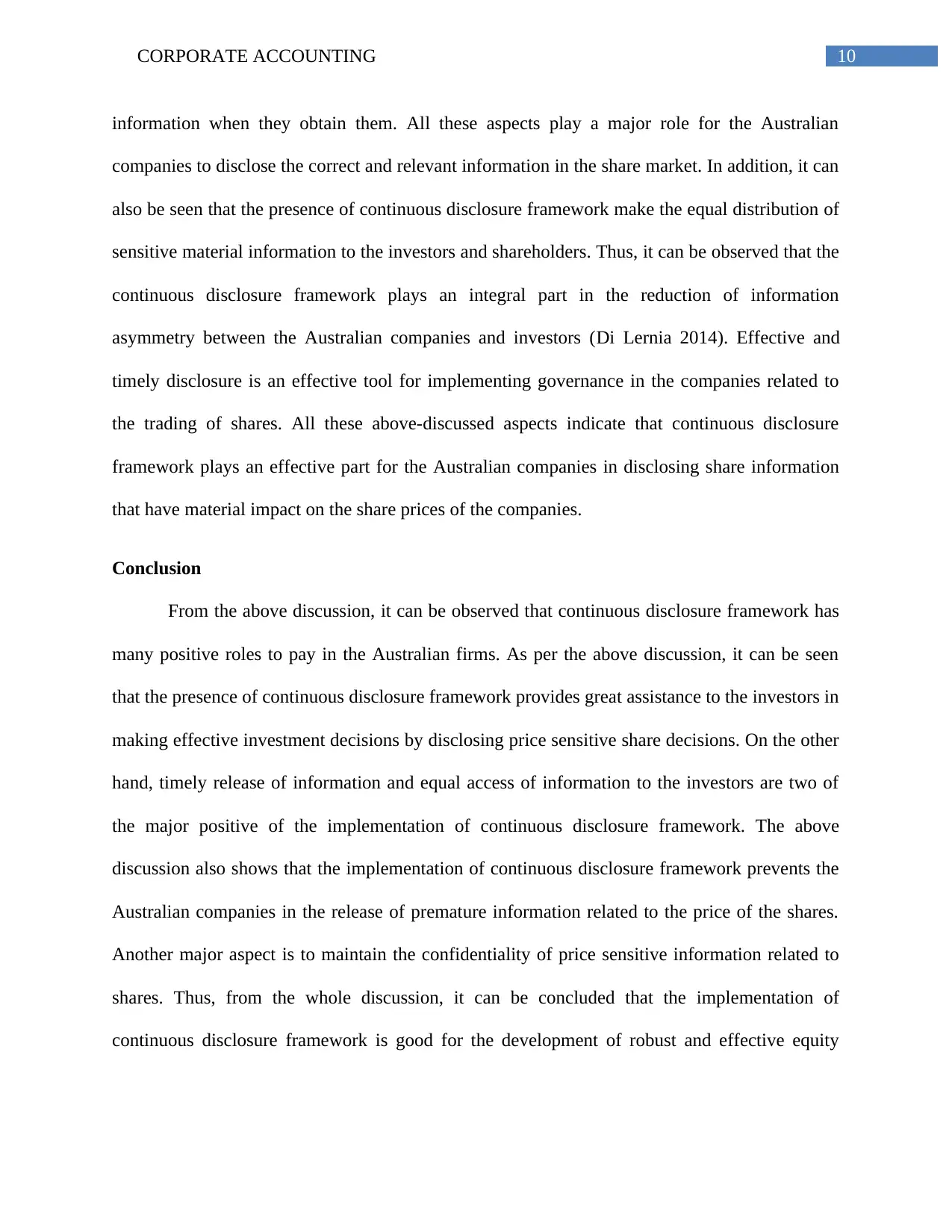
10CORPORATE ACCOUNTING
information when they obtain them. All these aspects play a major role for the Australian
companies to disclose the correct and relevant information in the share market. In addition, it can
also be seen that the presence of continuous disclosure framework make the equal distribution of
sensitive material information to the investors and shareholders. Thus, it can be observed that the
continuous disclosure framework plays an integral part in the reduction of information
asymmetry between the Australian companies and investors (Di Lernia 2014). Effective and
timely disclosure is an effective tool for implementing governance in the companies related to
the trading of shares. All these above-discussed aspects indicate that continuous disclosure
framework plays an effective part for the Australian companies in disclosing share information
that have material impact on the share prices of the companies.
Conclusion
From the above discussion, it can be observed that continuous disclosure framework has
many positive roles to pay in the Australian firms. As per the above discussion, it can be seen
that the presence of continuous disclosure framework provides great assistance to the investors in
making effective investment decisions by disclosing price sensitive share decisions. On the other
hand, timely release of information and equal access of information to the investors are two of
the major positive of the implementation of continuous disclosure framework. The above
discussion also shows that the implementation of continuous disclosure framework prevents the
Australian companies in the release of premature information related to the price of the shares.
Another major aspect is to maintain the confidentiality of price sensitive information related to
shares. Thus, from the whole discussion, it can be concluded that the implementation of
continuous disclosure framework is good for the development of robust and effective equity
information when they obtain them. All these aspects play a major role for the Australian
companies to disclose the correct and relevant information in the share market. In addition, it can
also be seen that the presence of continuous disclosure framework make the equal distribution of
sensitive material information to the investors and shareholders. Thus, it can be observed that the
continuous disclosure framework plays an integral part in the reduction of information
asymmetry between the Australian companies and investors (Di Lernia 2014). Effective and
timely disclosure is an effective tool for implementing governance in the companies related to
the trading of shares. All these above-discussed aspects indicate that continuous disclosure
framework plays an effective part for the Australian companies in disclosing share information
that have material impact on the share prices of the companies.
Conclusion
From the above discussion, it can be observed that continuous disclosure framework has
many positive roles to pay in the Australian firms. As per the above discussion, it can be seen
that the presence of continuous disclosure framework provides great assistance to the investors in
making effective investment decisions by disclosing price sensitive share decisions. On the other
hand, timely release of information and equal access of information to the investors are two of
the major positive of the implementation of continuous disclosure framework. The above
discussion also shows that the implementation of continuous disclosure framework prevents the
Australian companies in the release of premature information related to the price of the shares.
Another major aspect is to maintain the confidentiality of price sensitive information related to
shares. Thus, from the whole discussion, it can be concluded that the implementation of
continuous disclosure framework is good for the development of robust and effective equity
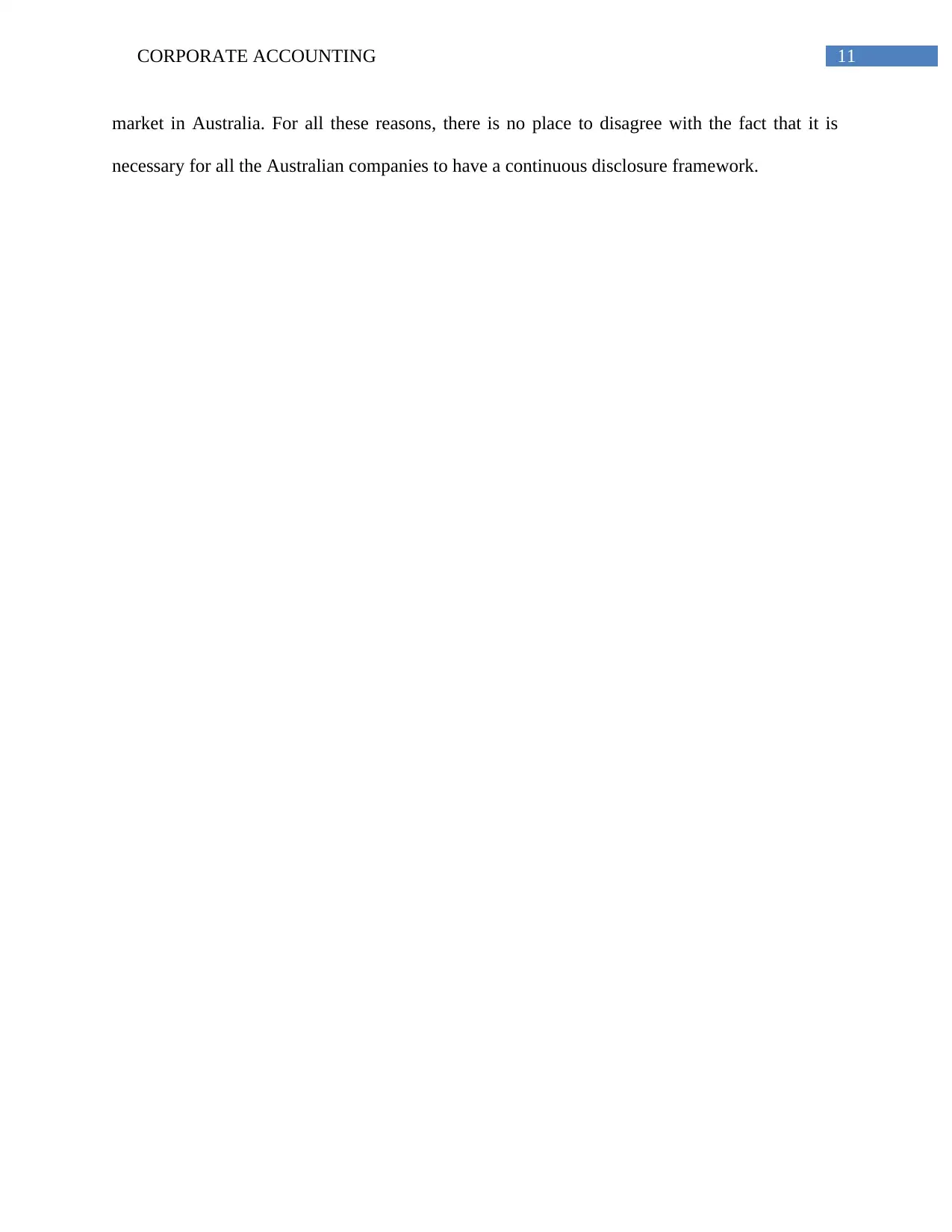
11CORPORATE ACCOUNTING
market in Australia. For all these reasons, there is no place to disagree with the fact that it is
necessary for all the Australian companies to have a continuous disclosure framework.
market in Australia. For all these reasons, there is no place to disagree with the fact that it is
necessary for all the Australian companies to have a continuous disclosure framework.
⊘ This is a preview!⊘
Do you want full access?
Subscribe today to unlock all pages.

Trusted by 1+ million students worldwide
1 out of 15
Related Documents
Your All-in-One AI-Powered Toolkit for Academic Success.
+13062052269
info@desklib.com
Available 24*7 on WhatsApp / Email
![[object Object]](/_next/static/media/star-bottom.7253800d.svg)
Unlock your academic potential
Copyright © 2020–2025 A2Z Services. All Rights Reserved. Developed and managed by ZUCOL.





